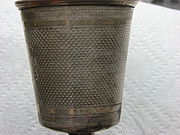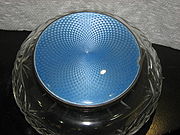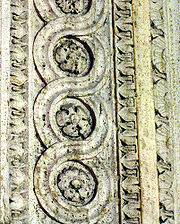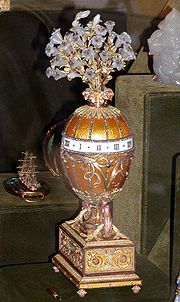
Guilloché
Encyclopedia





Engraving
Engraving is the practice of incising a design on to a hard, usually flat surface, by cutting grooves into it. The result may be a decorated object in itself, as when silver, gold, steel, or glass are engraved, or may provide an intaglio printing plate, of copper or another metal, for printing...
technique in which a very precise intricate repetitive pattern
Pattern
A pattern, from the French patron, is a type of theme of recurring events or objects, sometimes referred to as elements of a set of objects.These elements repeat in a predictable manner...
or design is mechanically engraved into an underlying material with fine detail. Specifically, it involves a technique of engine turning, called guilloché in French
French language
French is a Romance language spoken as a first language in France, the Romandy region in Switzerland, Wallonia and Brussels in Belgium, Monaco, the regions of Quebec and Acadia in Canada, and by various communities elsewhere. Second-language speakers of French are distributed throughout many parts...
after the French engineer “Guillot”, who invented a machine “that could scratch fine patterns and designs on metallic surfaces”. The machine improved upon the more time-consuming practice of making similar designs by hand, allowing for greater delicacy, precision, and closeness of the line, as well as greater speed.
Another account gives the credit of inventing this method to Hans Schwanhardt (- 1621) and the spreading of it, to his son-in-law Jacob Heppner (1645).
Yet another account is that it derives from the French
French language
French is a Romance language spoken as a first language in France, the Romandy region in Switzerland, Wallonia and Brussels in Belgium, Monaco, the regions of Quebec and Acadia in Canada, and by various communities elsewhere. Second-language speakers of French are distributed throughout many parts...
word for an engraving tool, not the engine turning machine.
A guilloche is a repetitive architectural pattern used in classical Greece and Rome, and neo-classical architecture as well as medieval Cosmatesque
Cosmatesque
Cosmatesque, or Cosmati, is a style of geometric decorative inlay stonework typical of Medieval Italy, and especially of Rome and its surroundings. It was used most extensively for the decoration of church floors, but was also used to decorate church walls, pulpits, and bishop's thrones...
stone inlay work, of two ribbons winding around a series of regular central points. These central points are often blank, but may contain a figure, such as a rose. Guilloche is a back-formation from guilloché, so called because the architectural motif resembles the designs produced by Guilloche techniques.
History
Engine turning machines were first used in the 1500–1600s on soft materials like ivory and wood and in the 18th century it was adopted for metal such as gold and silver.The last machines were manufactured around 1948–1949.
In the 1920s and '30s, automobile parts such as valve covers, which are right on top of the engine, were also engine-turned. Similarly, dashboard
Dashboard
A dashboard is a control panel placed in front of the driver of an automobile, housing instrumentation and controls for operation of the vehicle....
s or the instrument panel of the same were often engine-turned. Customizers
Custom car
A custom car is a passenger vehicle that has been modified in either of the following two ways. First, a custom car may be altered to improve its performance, often by altering or replacing the engine and transmission. Second, a custom car may be a personal "styling" statement, making the car look...
also would decorate their vehicles with engine-turning panels similarly.
Guilloche describes a narrow instance of guilloche: a design, frequently architectural, using two curved bands that interlace in a pattern around a central space. Some dictionaries give only this definition of guilloche, although others include the broader meaning associated with guilloché as a second meaning. Note that in the original sense, even a straight line can be guilloché, and persons using the French spelling and pronunciation generally intend the broader, original meaning.
Translucent enamel
Vitreous enamel
Vitreous enamel, also porcelain enamel in U.S. English, is a material made by fusing powdered glass to a substrate by firing, usually between 750 and 850 °C...
was applied over guilloché metal by Peter Carl Fabergé
Peter Carl Fabergé
Peter Karl Fabergé also known as Karl Gustavovich Fabergé in Russia was a Russian jeweller of Baltic German-Danish and French origin, best known for the famous Fabergé eggs, made in the style of genuine Easter eggs, but using precious metals and gemstones rather than more mundane materials.-Early...
on the Faberge eggs and other pieces from the 1880s.
In today’s terminology
In consequence of the nature of the design, which is usually a series of lines that are, or look very much like they are interwoven into one another, any design engraved on metal, printed, or otherwise erected on surfaces such as wood or stone, that go in a similar style of constant wriggling that interlock - or look like they are interlocking - with one another, is referred to as guilloché.Some of the more common ones are the following:
- Engraved (in metal, mainly sterling): in fine timepieces (mainly pocket watches), fine pens, jewelry charms, snuffboxes, hair-styling accessories, wine goblets etc. Examples of famous works of Guilloché are the engravings on Faberge eggs.
- Erected: on stone for architecture, in wood for styling, on furniture or molding, etc.
- Printed: on bank notes, currency or certificates, etc., to protect against forged copiesCounterfeitTo counterfeit means to illegally imitate something. Counterfeit products are often produced with the intent to take advantage of the superior value of the imitated product...
. The pattern used in this instance is called a spirographSpirographSpirograph is a geometric drawing toy that produces mathematical curves of the variety technically known as hypotrochoids and epitrochoids. The term has also been used to describe a variety of software applications that display similar curves, and applied to the class of curves that can be produced...
in mathematics, that is, a hypotrochoidHypotrochoidA hypotrochoid is a roulette traced by a point attached to a circle of radius r rolling around the inside of a fixed circle of radius R, where the point is a distance d from the center of the interior circle....
generated by a fixed point on a circle rolling inside a fixed circle. It has parametric equations. These patterns bear a strong resemblance to the designs produced on the SpirographSpirographSpirograph is a geometric drawing toy that produces mathematical curves of the variety technically known as hypotrochoids and epitrochoids. The term has also been used to describe a variety of software applications that display similar curves, and applied to the class of curves that can be produced...
, a children's toy.
Other names for Guilloché
The engine turning machine characteristic of Guilloché is called by other names in specific uses:- Rose engineRose engine latheA rose engine lathe is a specialized kind of geometric lathe. The headstock rocks back and forth with a rocking motion or along the spindle axis in a pumping motion, controlled by a rubber moving against a rosette or cam-like pattern mounted on the spindle, while the lathe spindle rotates...
(metalwork) - straight line engine turning Tour à guilloché (metalwork)
- HoltzapffelHoltzapffelHoltzapffel & Co. was a tool and lathe making company in London, founded by German immigrant, John Jacob Holtzapffel in 1793. The firm specialized in lathes for ornamental turning, something that was a popular leisure occupation for gentlemen at that time. Many ornamental lathes were bought by the...
lathe, named after the founder of an ornamental lathe manufacturer John Jacob HoltzapffelHoltzapffelHoltzapffel & Co. was a tool and lathe making company in London, founded by German immigrant, John Jacob Holtzapffel in 1793. The firm specialized in lathes for ornamental turning, something that was a popular leisure occupation for gentlemen at that time. Many ornamental lathes were bought by the... - Decoration lathe (metalwork)
- damaskeeningDamaskeeningIn horology, damaskeening is decorative patterning on a watch movement. The term damaskeening is used in America, while in Europe the terms used are Fausses Côtes, Côtes de Genève or Geneva Stripes. Such patterns are made from very fine scratches made by rose engine lathe using small disks,...
(watch movements and horology) - Geometric latheGeometric latheA geometric lathe was used for making ornamental patterns on the plates used in printing bank notes and postage stamps. It is sometimes called a Guilloché lathe. It was developed early in the nineteenth century when efforts were introduced to combat forgery, and is an adaptation of an ornamental...
(security printing) - Cycloidal engines (security printing)
- Ornamental turningOrnamental turningOrnamental turning is a type of turning, a craft that involves cutting of a work mounted in a lathe. The work can be made of any material that is suitable for being cut in this way, such as wood, bone, ivory or metal. Plain turning is work executed on a lathe where a transverse section through any...
or ornamental lathe (woodcarving).
The different types of the machines refer to different models and different times during the development of the engine-turning machine.

